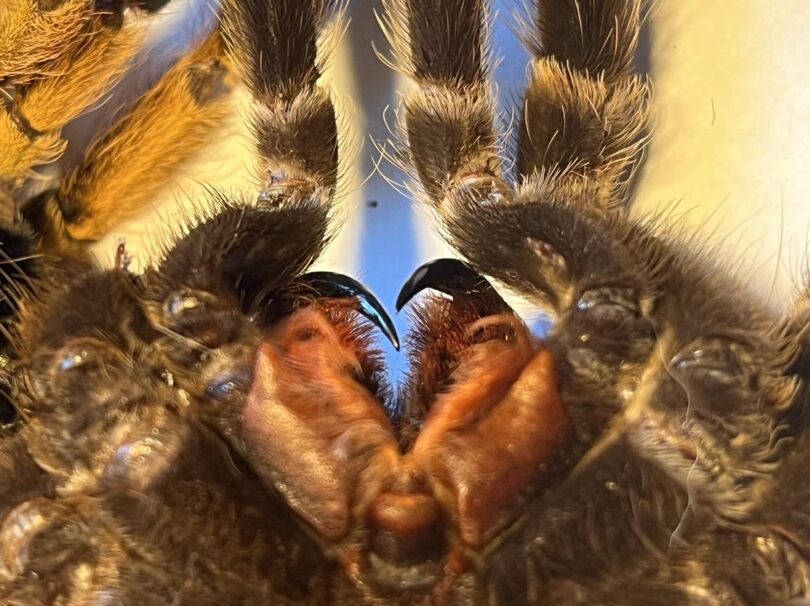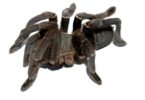Have you ever wondered what would happen if a tarantula decided to bite? Despite their fearsome reputation, tarantulas actually pose little danger to humans. This blog post is here to unravel the mystery behind those hairy arachnids and ease your mind about their bites.
Stick around—you might be surprised by what you learn!
Understanding Tarantulas
Tarantulas are large spiders that can reach up to 30 centimeters in leg span. They belong to the group of arthropods, and all of them are venomous. A significant number of them also have urticating hairs on their abdomens.
When threatened, they can shoot these hairs at an attacker. This defense helps tarantulas survive in the wild.
Their bites do have venom, but it’s rare for them to bite people. Most times, people get hurt from the tarantula’s hairs rather than their bite. These hairs cause skin problems like redness and itching when they touch your skin.
It’s good to know that while tarantulas might look scary, their bites usually aren’t very dangerous to humans.
Symptoms and Effects of a Tarantula Bite
When a tarantula bites, it’s not just the stuff of nightmares—though not typically life-threatening, the aftermath can pack a punch with symptoms that certainly grab your attention.
Let’s dive into the nitty-gritty of tarantula bite effects—from the telltale marks they leave to the surprising sensations they might cause.
Physical Appearance of the Bite
A tarantula bite might look a bit like you got stung by a bee. You’ll see some redness and the skin around the bite could puff up. It’s not just the bite that causes trouble, either.
Those tiny hairs on a tarantula can also irritate your skin if they touch you. They stick to your skin and may make it very itchy, red, and swollen – almost like you brushed against something prickly.
The spot where a tarantula bites doesn’t always look the same on everyone. Some people get only a small mark while others have more obvious signs like big red patches or swelling. But no matter how it shows up, this type of spider bite is usually less about looks and more about how it feels!
Associated Pain and Discomfort
After seeing how a tarantula bite looks, let’s talk about how it feels. These bites often hurt like a bee sting or wasp sting. Your skin might get red and swell up where the spider bit you.
Some people also feel itchy. Old World species can cause additional symptoms with their bites, such as muscle cramps, nausea, fever, or blood pressure issues—signs that the whole body is reacting poorly to the bite.
It’s not pleasant to be bitten by one of your pets; they can cause real pain and discomfort that lasts for up to a week.
Response and Treatment for a Tarantula Bite
A tarantula bite might scare you, but most times it’s not too bad. Keeping calm and taking care of the bite right away can help a lot.
- Clean the bite with soap and water to prevent infection.
- Apply a cool compress to ease swelling and pain.
- Take over-the-counter pain relievers like ibuprofen if it hurts.
- Keep an eye on the bite for signs of more serious problems, such as spreading redness or swelling.
- Use Neosporin or similar creams to stop bacteria and keep the wound clean.
- If your whole body starts to feel bad or you can’t breathe well, go to the emergency room fast. This could be an allergic reaction.
- Observe vital signs like heartbeat and breathing in case something seems wrong.
Summary
So, getting bit by a tarantula can be scary, but it’s usually not too bad. Most of the time, if one does bite you, it’ll hurt about as much as a bee sting. Remember to take care of the bite and see a doctor if it looks weird or feels really bad.
FAQs
1. Can a tarantula bite you?
Yes, a tarantula can bite you, but it’s rare. They usually only bite if they feel threatened.
2. Does a tarantula bite hurt?
The bite itself is not necessarily very painful, although the fangs of some species can be over 2 centimeters long. The real pain may only appear some time after the bite if you have encountered an Old World species.
3. Has anyone died from a tarantula bite?
4. Are all tarantulas venomous?
Not all spiders in the world are venomous, but tarantulas are.
5. What tarantula has the worst bite?
Species with the worst bite effects include Poecilotheria, Stromatopelma, and Heteroscodra. Many bite reports also indicate that the most painful bite can be experienced from Pterinochilus murinus, as the pain is described as similar to having a heated piece of metal driven into the bite site.
6. What happens if a tarantula bites my dog?
Any animal smaller than a human will have a harder time with a bite, especially from a tarantula originating from Asia or Africa, and it is advisable to visit a veterinarian in such cases. Death from a bite can only occur if it involves small puppies of the smallest breeds or old and sick dogs.







